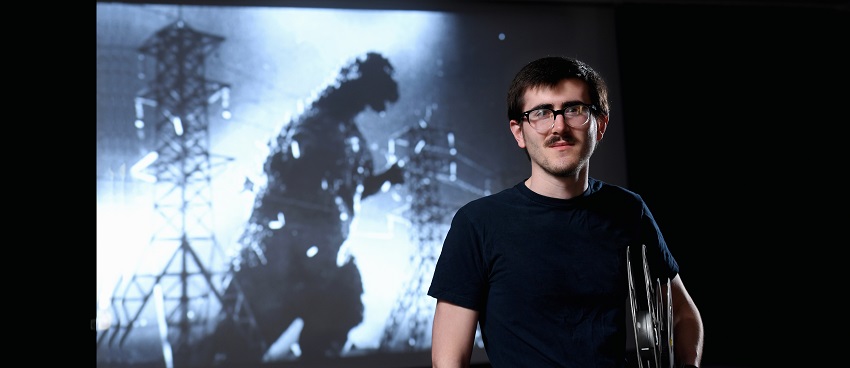Preservation man
Preservation man

For many Rowan Radio, Television & Film (RTF) majors, the popular degree program leads to a career in creating.
Robert Boddingham sees it as a path to preserving.
Boddingham, who graduated with honors Wednesday, May 9, will leave the College of Communication & Creative Arts with an RTF degree and head to the L. Jeffrey Selznick School of Film Preservation at the George Eastman Museum in Rochester, N.Y., where he’ll pursue a graduate certificate program.
The yearlong course of study will pair Boddingham with working film preservationists from whom he’ll learn techniques for preserving and restoring film that, left untreated, would break down and be lost forever.
According to the Selznick program’s web site, students are immersed in research and discovery. They’re trained in archival practices including curatorial duties; study the nature and purpose of copyright laws; learn to inspect, repair, measure and ship nitrate prints; and learn to organize and manage climatized vaults where film can be preserved.
Fighting ‘vinegar syndrome’
A natural chemical process, sometimes called vinegar syndrome for the odor emitted by the disintegrating material, causes film to degrade even if it is stored optimally.
While not all film can be saved, state of the art techniques are helping to limit the loss of films that, once lost, would be gone forever.
“Film preservation is important because there are so many films that are just rotting away,” Boddingham says. “We know for sure that 75 percent or more of silent films are gone. So many films have been made and forgotten about, but they really might connect with viewers. I believe if someone went through so much trouble to make a film, we should do our best to preserve it.”
Boddingham, 21, has a special affinity for classic black-and-white movies, silent films and early “talkies” with such stars as Buster Keaton, King Kong and Godzilla.
A Gloucester City High School graduate who expects to walk at Commencement with a 3.6 GPA or better, Boddingham developed a passion for preservation over time, in tandem with a growing appreciation for such historic films.
“Like a lot of RTF majors, I had always dreamed of being a director,” he says. “I made small short films in high school and never saw myself doing anything other than directing, probably from age seven or eight.”
But as he progressed through Rowan’s RTF program, it wasn’t the production courses that spoke to Boddingham most. Rather, it was courses about film appreciation and history, classes that delved into the origins of moviemaking, and Boddingham realized that was his passion all along.
“That’s where I shined,” he says. “The first time I saw Buster Keaton’s The General or Charlie Chaplin’s The Gold Rush something just clicked. I love Looney Tunes (cartoons) and when I watch a Charlie Chaplin movie I realize that’s where Looney Tunes got their schtick.”
Already curating and preserving historic work
Boddingham’s application to Selznick included, in addition to a top GPA and first-class recommendations, a body of work that, in itself, is historic. Starting in high school, he began working with still images contained in English photographer Eadweard Muybridge’s Animal Locomotion series.
Working at the University of Pennsylvania in the 1800s, Muybridge used a stop-action technique to produce more than 23,000 sequential images of animals and humans, some of them nudes, in motion.
Boddingham, upon discovering the vast trove of still sequences online, began downloading groups of Muybridge’s 19th century images and, using photo editing software, animated them for 21st century YouTube viewers.
“The images are available for free online but they’re not in a moving format as he intended and there’s really nowhere to see them,” Boddingham says. “I’d download the images, put them together and run them at the correct speed.”
Rising film scholar
In a letter of recommendation for Boddingham to the Selznick program, Rowan Professor of Film History Sheri Chinen Biesen described her student and advisee as an individual of “extraordinary ability, passionate commitment to film preservation, intellectual rigor and maturity.”
She said Boddingham, who was a consistent “A” student in every course in which she taught him – Film History (Since 1940), American Film Directors, and Film Noir classes – has discovered a passion in film preservation that can have a deep and long-lasting impact.
“He clearly has a passion for cinema and film preservation, which is really wonderful because preserving our motion picture heritage is incredibly important,” Biesen said.
“It’s a vital area of our field in terms of graduate study and a career… and he showed incredible initiative in conducting extensive archival research at the University of Pennsylvania to engage in film preservation efforts of his own to restore early filmmaking experiments.”
Boddingham is excited about the career he’s charting, an important--if somewhat unusual--one in his field.
“For the longest time I knew I liked old movies but didn’t see any sort of career path,” he says. “But why old movies? There were so many logistical things back then that were different.
“For example, they used to shoot on film, which they really don’t anymore. And you had to capture the magic back there while you were shooting, you couldn’t go back and fix it in the editing room. It’s brighter and yet darker…much more lifelike to me.”